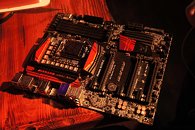Tuesday, May 5th 2015

Colorful iGame-Z170 Motherboard Pictured
Here is the first picture of Colorful's premium socket LGA1151 motherboard, the iGame-Z170. The company plans to carve out at lease three unique SKUs out of this PCB (second picture below), the iGame-Z170 being the base model. As its name suggests, the board is based on Intel's upcoming Z170 Express chipset, and is designed for 6th generation Core "Skylake" processors. Some variants of this board, such as the iGame-Z170U, will feature DDR4 DIMM slots (up to 64 GB), while others will feature DDR3 (up to 32 GB).
The board offers a pretty decent feature-set, including a 14-phase CPU VRM, two PCI-Express 3.0 x16 slots (electrical x8/x8 when both are populated) wired to the CPU, a third PCI-Express x4 slot wired to the PCH, three other PCI-Express x1 slots; storage connectivity that includes six SATA 6 Gb/s, one SATA-Express, and one M.2 10 Gb/s; two USB 3.1 ports, six USB 3.0 ports, gigabit Ethernet, and a modern onboard audio solution with ground-layer isolation, and audio-grade capacitors. The iGame-Z170 series will launch some time in Q3, 2015. The three will likely be exhibited at Computex 2015, this June.
The board offers a pretty decent feature-set, including a 14-phase CPU VRM, two PCI-Express 3.0 x16 slots (electrical x8/x8 when both are populated) wired to the CPU, a third PCI-Express x4 slot wired to the PCH, three other PCI-Express x1 slots; storage connectivity that includes six SATA 6 Gb/s, one SATA-Express, and one M.2 10 Gb/s; two USB 3.1 ports, six USB 3.0 ports, gigabit Ethernet, and a modern onboard audio solution with ground-layer isolation, and audio-grade capacitors. The iGame-Z170 series will launch some time in Q3, 2015. The three will likely be exhibited at Computex 2015, this June.


24 Comments on Colorful iGame-Z170 Motherboard Pictured
Not compatible with Intel 750 SSD and Samsung SM951 maximum speeds.
THANK.
F**KING.
GOD.
It's about damn time that mobo manufacturers stopped cramming IGP outputs onto supposed "high-end" boards. Hopefully Skylake will be the generation that this practice finally dies for good.
what a waste of time if you got 2 excellent graphics cards and want the best crossfire YOU WANT (electrical x16/x16 when both are populated)
Plus, instead of DVI, all you get is a single HDMI out and a second LAN port (which probably won't support aggregation), not to mention a tonne of USB ports you're never going to use/be able to reach sensibly for memory sticks. How many people actually use rear USB 3.0 slots when they have 2 front ports?
I agree on the VGA front though. Needs to die immediately. Just would have liked to see at least 2 digital out ports like HDMI and DP.I'm guessing Sata Express, M.2 10Gb and USB 3.1 take up a butt-load of lanes, accounting for the x8/x8 only PCI-E 3.0 lanes. Plus x8 is more than enough for a high end single GPU anyway.
For them and there are alot of them skylake will be a no upgrade path
And if you really do, then you can buy PCIe card for 6£:
uk.pcpartpicker.com/part/tp-link-wired-network-card-tg3468
for what else are you going to use those short PCIe slots anyway other than ethernet cards? :p
Also if you look the second picture ... don't they all have 2 ethernet ports? (angle is a bit bad ... but seems those are ethernet ports.)
It is also good if you have a separate network completely independent (no subnetting) on which you can have NAS device or any device only you want physical acces to.
Load balancing is also wanted because 125 MB/s maximum is very slow especially if you are transferring large amount of data.
Nowadays some people also have or will have 1Gbps internet connection which means you need at least 2 GbE ports and even then the connection probably won't be fully utilized.
And you can also use more GbE ports if one route stops working (faulty switch) you still have second working route.
Second GbE port adds numerous possibilities.
Edit: also this (original has glare)...
More importantly, what are you doing using a high-performance desktop as a router? A pithy dual-core Atom can easily push multiple gigabits of NATted traffic when running something like OPNSense or pfSense (less for VPN because of crypto, obviously, but why are you VPNing to your LAN when you're already on the LAN?).
As for maxxing out a Gbit line, a single Gbit port is all you need. If you can't max out the line in terms of RAW bandwidth (as opposed to usable bandwidth once you strip overheads - HTTP/FTP/SSH/blah control data, TCP/UDP, IP, Ethernet, and any other encapsulation) with a single port in these days of fast CPUs, you're doing something wrong somewhere else.
The only valid argument you make is the redundancy argument, and I'll agree with that.
That said, I personally run aggregated ports on my desktop and VM hosts, because I transfer a fair bit between the two, and would like to not have congestion when I push or pull a VM (or more, as the case may be).
or a parallel port for your printer........
Also if your computer case has wheels, you could use it as a skateboard :)
Seriously. Last time I had to use computer as a router was somewhere between 1990 and 1998. Around then were introduced (relatively) cheap consumer standalone small boxes that did this times better and more effectively with their routing ASICs than any computer.